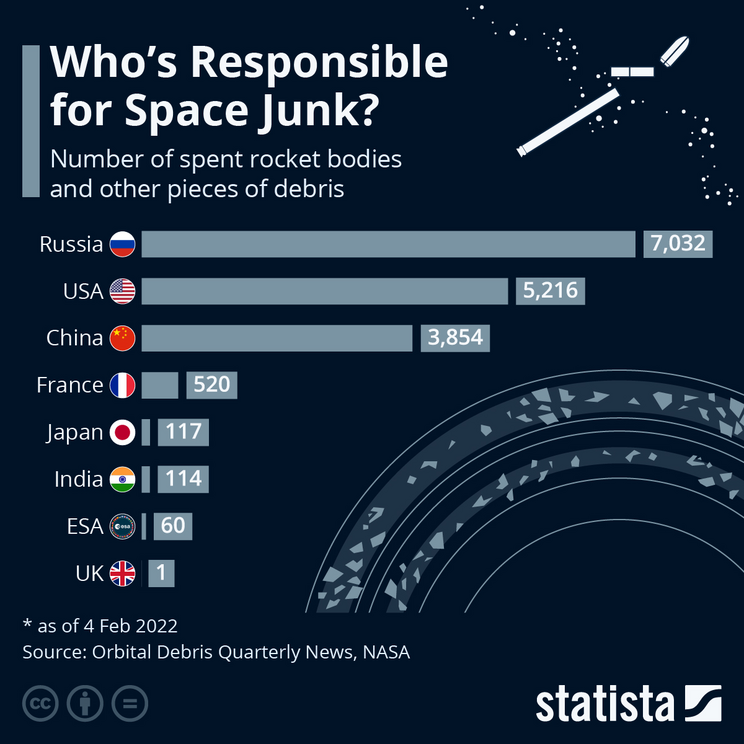Who's responsible for space junk?
It turns out that, after polluting our planet, we are now polluting space. Thousands of pieces of debris from broken down satellites, rocket boosters and weapons tests that we’ve launched over the years have got stuck in orbit, creating clutter, which could not only crash into the active satellites we need for monitoring the Earth but also release harmful chemicals into the atmosphere as they burn up on re-entry, depleting the ozone layer, as well as potentially creating problems for future launches and space exploration.
As Statista's Anna Fleck shows in the chart below, most space junk comes from three countries: Russia, the U.S. and China.
You will find more infographics at Statista
Last November, Russia blew up one of its old satellites using an anti-satellite (ASAT) weapon, sending thousands of pieces of debris into orbit and risked hitting the International Space Station. The Secure World Foundation estimates at least 16 debris-creating ASAT weapons tests have been carried out to date, with the most potentially damaging carried out by China in 2007, as the country downed one of their own satellites, creating an estimated 3,000 pieces of debris. However, it was the U.S. that created the first ASAT test, back in the 1950s, and according to Data Center Dynamics, has since conducted at least three ASAT debris-creating tests; two in the mid-1980s and one in 2008.
According to the OECD, active debris removal faces several “technological, geopolitical and economic challenges.”
Manufacturing and launching debris removal vehicles is expensive and, if it goes wrong, there’s the risk of simply creating further debris.
On top of this, OECD analysts explain:
“the retrieval of debris could involve sharing potentially sensitive data about the debris object’s design that could involve national security, foreign policy, intellectual property, etc. Therefore, countries would realistically be limited to removing their own satellites or those of close military allies.”
Despite this, a number of space missions are planned over the next few years, including the European Space Agency’s ClearSpace-1 and the Japanese Commercial Removal of Debris Demonstration (CRD2) mission. According to the OECD, possible solutions that are being worked on include space or ground based lasers to “nudge” objects out of the way, as well as the possibility to create an “artificial atmosphere” to divert its orbit. The organization’s analysts conclude: “All legal, technological and economic hurdles aside, these approaches depend on a much more accurate capability of space situational awareness and space tracking than exists today.”
Evidently the issue of space debris will need to be solved soon as companies such as Boeing Co. and SpaceX get set to launch some 65,000 spacecraft into low-Earth orbit, upping the likelihood of more collisions and even further debris in the future.

